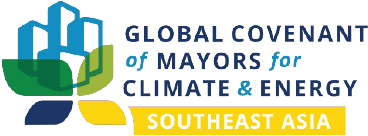To follow up on the previous discussion on GHG inventory back in April 2020, IUC Asia and CCROM met the Malang City stakeholders virtually on 24 August 2020. Malang municipalities have completed the 2018 Green House Gases (GHG) inventory report and 2018 City Action Plan. The agenda of the meeting was to deliver the gap analysis result of those reports performed by CCROM, among other things.
The review of the GHG inventory report revealed some gaps, specifically inconsistency emission factors applied in the report; some missing GHG activity data, and incomplete waste sector methodology. Some suggestions were made to fill those gaps, included applying the top-down approach for the energy sector and seeking a reliable source for the data of the waste sector.
During the meeting, CCROM presented the 2019 GHG inventory report, which provides an interim snapshot of the GHG that Malang emits from 2016 up to 2019. The 2019 GHG activity data was estimated based on the historical data taken from the 2018 report, requires to be updated with reliable sources. The annual carbon emission between 2016 and 2019 remained flat, an increase of 0.8% attributed to the rise in population. The residential continues to be the dominant source of Malang’s GHG emissions in 2019, accounting for 53% of total emission, followed by energy consumption from the commercial buildings (19%), the transportation sector (14%), and the waste sector contributes 11%. Malang’s per capita value of 1.5 tCO2 versus 3.5 tCO2 for Palembang reflects the small impact of the industry activities. This is corresponding with the main economic activities in Malang in which the service sector, e.g., retail, tourism contributes to the dominant sector.
The session continued with the discussion of baseline emission. The projected 2030 emission under CCROM’s estimation versus the 2018 Malang’s Action Plan was demonstrated, resulted in a difference of 4.8%. The meeting reached the agreement to follow the methodology adopted by CCROM, in which the baseline emission level in 2030 applied the average Malang’s GHG emissions for 2016-2019 as the base year. The Baseline emission in 2030 represented a Business-as-Usual (BAU) scenario assuming none of the mitigation measures implemented.
The meeting also discussed the approach to set the target of emission reduction. The approach entailed the several steps, 1) the identification of mitigation actions stipulated in the city /provincial/national policies; 2) to prioritize mitigation actions based on the results of the analysis of the main emission sources and priority areas, and their contribution to achieving SDG targets; 3) final determination of mitigation strategies toward the emission reduction target; 4) develop mitigation plans for short and long term. The first step indicated the emission reduction of 13% compared to BAU levels by 2030. The outcome of the meeting suggested to finalize step 2) with the good quality data as recommended by CCROM in the gap analysis.




